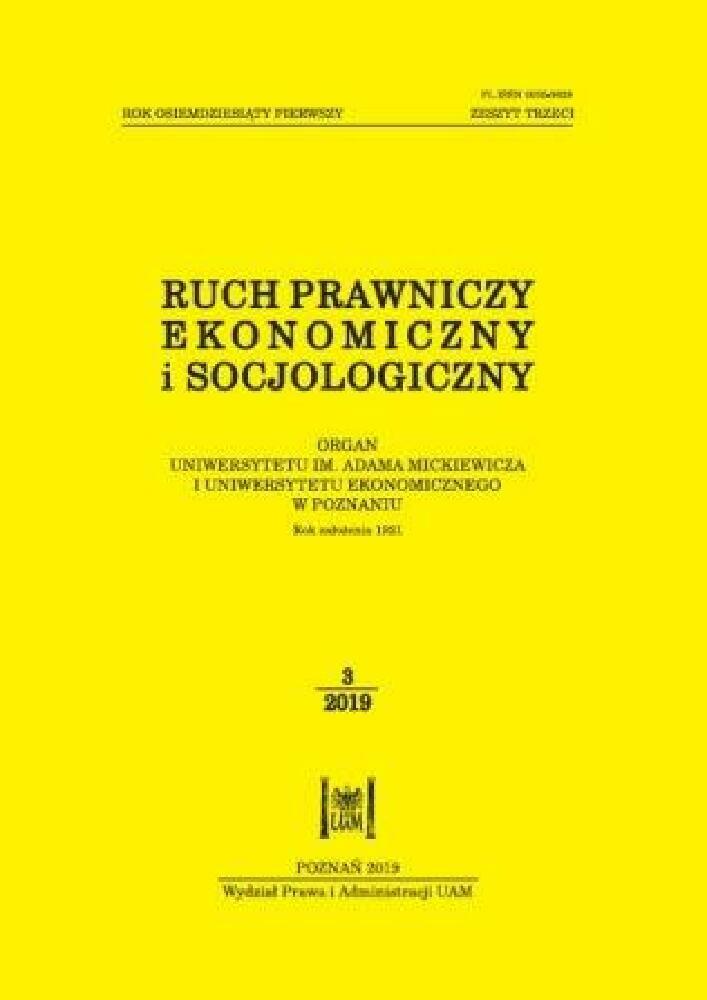Abstract
The research undertaken focused on a specific group: Poles aged 35 and over, thus representing so-called Generation X. The main objective of the study was to check which factors affect overall satisfaction with life, as well as how to what extent, which was measured as a weighted average of partial satisfaction indicators from 21 different spheres of life. The weights used to establish this general indicator were the declarations of respondents on how important every sphere is in their life, how much they want to be implemented in it. To achieve this goal, the results of a survey conducted in the first half of 2017 on a sample of 1,110 respondents from the Wielkopolska Voivodeship were used, and in determining what factors significantly determine a high or low level of satisfaction a multidimensional regression analysis was used. The results of the modeling process indicated 14 out of a potential 41 determinants of happiness, and the set of these factors includes the following characteristics of respondents: having children, the number of children, being financially independent, the value of property, place of residence, experiencing or not experiencing great failure in life, level of freedom/ liberty, level of safety, fitness level, self-assessment of health, number of sexual contacts, social prestige, level of extraversion and level of conscientiousness. In addition, it turned out that some of these factors positively affect the level of satisfaction, some negatively, and this influence is also manifested with varying intensity.Funding
National Science Centre Grant no. UMO-2013/11/D/H54/03933
References
Albouy, D. (2008). Are big cities bad places to live? Estimating quality of life across metropolitan areas. National Bureau of Economic Research Working Paper Series 14472.
Argyle, M. (2004). The Psychology of Happiness. London: Methuen.
Baranowska, A., Matysiak, A. (2011). Does parenthood increase happiness? Evidence for Poland. Vienna Yearbook of Population Research 9: 307–325.
Berry, B., Okulicz-Kozaryn, A. (2013). An urban-rural happiness gradient. Urban Geography 32(6): 871–883.
Boarini, R. (2015). Well-being and quality of life reporting at the OECD, [w:] W. Glatzer, L. Camfield, V. Møller, M. Rojas (eds.), Global Handbook of Quality of Life. Exploration of Well-Being of Nations and Continents, Springer.
Campbell, A., Converse, P.E., Rodgers, W. (1976). The Quality of American Life: Perceptions, Evaluations, and Satisfactions. New York: Russell Sage Foundation.
Cheng, Z., Smyth, R. (2015). Sex and happiness. Journal of Economic Behavior and Organization 112: 26–32.
Christoph, B., Noll, H.H. (2003). Subjective well-being in the European Union during the 90s. Social Indicators Research 64(3): 521–546.
Clark, A.E., Oswald, A.J. (1996). Satisfaction and comparison income. Journal of Public Economics 61(3): 359–381.
Cohen, M. (2008). The effect of crime on life satisfaction. Journal of Legal Studies 37: 325–353.
DeNeve, K.M., Cooper, H. (1998). The happy personality: a meta-analysis of 137 personality traits and subjective well-being. Psychological Bulletin 124: 197–229.
Diener, E., Oishi, S., Tay, L. (eds.) (2018). Handbook of Well-Being. Salt Lake City, UT: DEF Publishers.
Easterlin, R.A. (1995). Will raising the incomes of all increase the happiness of all? Journal of Economic Behavior and Organization 27(1): 35–47.
Ellenhorn, R. (2005). Parasuicidality and patient careerism: treatment recidivism and the dialectics of failure. American Journal of Orthopsychiatry 75: 288–303.
Furnham, A., Christoforou, I. (2007). Personality traits, emotional intelligence, and multiple happiness. North American Journal of Psychology 9: 439–462.
Hagerty, M.R., Veenhoven, R. (2003). Wealth and happiness revisited: growing wealth of nations does go with greater happiness. Social Indicators Research 64: 1–17.
Inglehart, R., Foa, R., Peterson, C., Welzel, C. (2008). Development, freedom, and rising happiness: a global perspective (1981–2007). Perspectives on Psychological Science 3(4): 264–285.
Kohler, H.P., Behrman, J.R., Skytthe, A. (2005). Partner + children = happiness? The effects of partnerships and fertility on well-being. Population and Development Review 31(3): 407–445.
Loewenstein, G., Krishnamurti, T., Kopsic, J., McDonald, D. (2015). Does increased sexual frequency enhance happiness? Journal of Economic Behavior and Organization 116: 206–218.
Margolis, R., Myrskyla, M. (2011). A Global Perspective on Happiness and Fertility. Population and Development Review 37(1): 29–56.
Michalos, A.C. (2007). Essays on the Quality of Life. Netherlands: Springer.
Okun, M.A., Stock, W.A., Haring M.J., Witter R.A. (1984). Health and subjective well-being: a meta-analysis. International Journal of Aging and Human Development 19: 111–132.
Ostasiewicz, W. (2004). Ocena i analiza jakości życia. Wrocław: Wydawnictwo Akademii Ekonomicznej im. Oskara Langego.
Oswald, A.J., Powdthavee, N. (2008). Does happiness adapt? A longitudinal study of disability with implications for economists and judges. Journal of Public Economics 88: 1359–1386.
Tanaka, K., Johnson, N.E. (2016). Childlessness and mental well-being in a global context. Journal of Family Issues 37(8): 1027–1045.
Werding, M. (2014). Children are costly, but raising them may pay: the economic approach to fertility. Demographic Research 30(Article 8): 253–276.
License
Copyright (c) 2019 WPiA UAM

This work is licensed under a Creative Commons Attribution-NonCommercial-NoDerivatives 4.0 International License.





